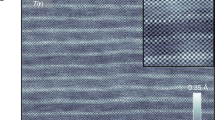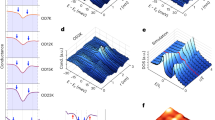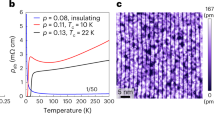Abstract
Pairing of electrons in conventional superconductors occurs at the superconducting transition temperature Tc, creating an energy gap Δ in the electronic density of states (DOS)1. In the high-Tc superconductors, a partial gap in the DOS exists for a range of temperatures above Tc (ref. 2). A key question is whether the gap in the DOS above Tc is associated with pairing, and what determines the temperature at which incoherent pairs form. Here we report the first spatially resolved measurements of gap formation in a high-Tc superconductor, measured on Bi2Sr2CaCu2O8+δ samples with different Tc values (hole concentration of 0.12 to 0.22) using scanning tunnelling microscopy. Over a wide range of doping from 0.16 to 0.22 we find that pairing gaps nucleate in nanoscale regions above Tc. These regions proliferate as the temperature is lowered, resulting in a spatial distribution of gap sizes in the superconducting state3,4,5. Despite the inhomogeneity, we find that every pairing gap develops locally at a temperature Tp, following the relation 2Δ/kBTp = 7.9 ± 0.5. At very low doping (≤0.14), systematic changes in the DOS indicate the presence of another phenomenon6,7,8,9, which is unrelated and perhaps competes with electron pairing. Our observation of nanometre-sized pairing regions provides the missing microscopic basis for understanding recent reports10,11,12,13 of fluctuating superconducting response above Tc in hole-doped high-Tc copper oxide superconductors.
This is a preview of subscription content, access via your institution
Access options
Subscribe to this journal
Receive 51 print issues and online access
$199.00 per year
only $3.90 per issue
Buy this article
- Purchase on Springer Link
- Instant access to full article PDF
Prices may be subject to local taxes which are calculated during checkout





Similar content being viewed by others
References
Tinkham, M. Introduction to Superconductivity (McGraw-Hill, New York, 1975)
Timusk, T. & Statt, B. The pseudogap in high-temperature superconductors: an experimental survey. Rep. Prog. Phys. 62, 61–122 (1999)
Howald, C., Fournier, P. & Kapitulnik, A. Inherent inhomogeneities in tunnelling spectra of Bi2Sr2CaCu2O8-x crystals in the superconducting state. Phys. Rev. B 64, 100504(R) (2001)
Pan, S. H. et al. Microscopic electronic inhomogeneity in the high-Tc superconductor Bi2Sr2CaCu2O8+x . Nature 413, 282–285 (2001)
McElroy, K. et al. Atomic-scale sources and mechanism of nanoscale electronic disorder in Bi2Sr2CaCu2O8+δ . Science 309, 1048–1052 (2005)
Tallon, J. L. & Loram, J. W. The doping dependence of T*—what is the real high-Tc phase diagram? Physica C 349, 53–68 (2001)
Kivelson, S. A. et al. How to detect fluctuating stripes in the high-temperature superconductors. Rev. Mod. Phys. 75, 1201–1241 (2003)
Norman, M. R., Pines, D. & Kallin, C. The pseudogap: friend or foe of high Tc? Adv. Phys. 54, 715–733 (2005)
Lee, P. A., Nagaosa, N. & Wen, X.-G. Doping a Mott insulator: physics of high-temperature superconductivity. Rev. Mod. Phys. 78, 17–86 (2006)
Corson, J., Mallozzi, R., Orenstein, J., Eckstein, J. N. & Bozovic, I. Vanishing of phase coherence in underdoped Bi2Sr2CaCu2O8+δ . Nature 398, 221–223 (1999)
Xu, Z. A., Ong, N. P., Wang, Y., Kakeshita, T. & Uchida, S. Vortex-like excitations and the onset of superconducting phase fluctuation in underdoped La2-xSrxCuO4 . Nature 406, 486–488 (2000)
Wang, Y. et al. Field-enhanced diamagnetism in the pseudogap state of the cuprate Bi2Sr2CaCu2O8+δ superconductor in an intense magnetic field. Phys. Rev. Lett. 95, 247002 (2005)
Wang, Y., Li, L. & Ong, N. P. Nernst effect in high-Tc superconductors. Phys. Rev. B 73, 024510 (2006)
Emery, V. J. & Kivelson, S. A. Importance of phase fluctuations in superconductors with small superfluid density. Nature 374, 434–437 (1995)
Randeria, M. in Proc. Int. School of Physics 'Enrico Fermi' on Conventional and High Temperature Superconductors (eds Iadonisi, G., Schrieffer, J. R. & Chiafalo, M. L.) 53–75 (IOS Press, Amsterdam, 1998)
Vershinin, M. et al. Local ordering in the pseudogap state of the high-Tc superconductor Bi2Sr2CaCu2O8+δ . Science 303, 1995–1998 (2004)
Hanaguri, T. et al. A 'checkerboard' electronic crystal state in lightly hole-doped Ca2-xNaxCuO2Cl2 . Nature 430, 1001–1005 (2004)
McElroy, K. et al. Coincidence of checkerboard charge order and antinodal state decoherence in strongly underdoped superconducting Bi2Sr2CaCu2O8+δ . Phys. Rev. Lett. 94, 197005 (2005)
Renner, Revaz, B., Genoud, J.-Y., Kadowaki, K. & Fischer, Ø. Pseudogap precursor of the superconducting gap in under- and overdoped Bi2Sr2CaCu2O8+δ . Phys. Rev. Lett. 80, 149–152 (1998)
Kugler, M., Fischer, Ø., Renner, Ono, S. & Ando, Y. Scanning tunneling spectroscopy of Bi2Sr2CuO6+δ: new evidence for the common origin of the pseudogap and superconductivity. Phys. Rev. Lett. 86, 4911–4914 (2001)
Deutscher, G. Coherence and single particle excitations in high temperature superconductors. Nature 397, 410–412 (1999)
Andersen, B. M., Melikyan, A., Nunner, T. S. & Hirschfeld, P. J. Thermodynamic transitions in inhomogeneous d-wave superconductors. Phys. Rev. B 74, 060501(R) (2006)
Norman, M. R. et al. Destruction of the Fermi surface in underdoped high-Tc superconductors. Nature 397, 157–160 (1998)
Valla, T., Fedorov, A. V., Lee, J., Davis, J. C. & Gu, G. D. The ground state of the pseudogap in cuprate superconductors. Science 314, 1914–1916 (2006)
Tanaka, K. et al. Distinct Fermi-momentum-dependent energy gaps in deeply underdoped Bi2212. Science 314, 1910–1913 (2006)
Le Tacon, M. et al. Two energy scales and two distinct quasiparticle dynamics in the superconducting state of underdoped cuprates. Nature Phys. 2, 537–543 (2006)
Damascelli, A., Hussain, Z. & Shen, Z.-X. Angled-resolved photoemission studies of cuprate superconductors. Rev. Mod. Phys. 75, 473–541 (2003)
Carbotte, J. P. Properties of boson-exchange superconductors. Rev. Mod. Phys. 62, 1027–1157 (1990)
Balatsky, A. V. & Zhu, J.-X. Local strong coupling pairing in d-wave supercondcutors with inhomogeneous bosonic modes. Phys. Rev. B 74, 094517 (2006)
Acknowledgements
This work was supported by Princeton University, the NSF-DMR, and the NSF-MRSEC programme through the Princeton Center for Complex Materials.
Author information
Authors and Affiliations
Corresponding author
Ethics declarations
Competing interests
Reprints and permissions information is available at www.nature.com/reprints. The authors declare no competing financial interests.
Supplementary information
Supplementary Information
This file contains Supplementary Notes, Supplementary Figures S1-S7 with Legends and additional references. (PDF 1278 kb)
Rights and permissions
About this article
Cite this article
Gomes, K., Pasupathy, A., Pushp, A. et al. Visualizing pair formation on the atomic scale in the high-Tc superconductor Bi2Sr2CaCu2O8+δ. Nature 447, 569–572 (2007). https://doi.org/10.1038/nature05881
Received:
Accepted:
Issue Date:
DOI: https://doi.org/10.1038/nature05881
This article is cited by
-
The emergence of global phase coherence from local pairing in underdoped cuprates
Nature Physics (2023)
-
Fermi arc in p-wave holographic superconductors
Journal of High Energy Physics (2023)
-
Paramagnons and high-temperature superconductivity in a model family of cuprates
Nature Communications (2022)
-
Probing the evolution of electronic phase-coexistence in complex systems by terahertz radiation
Communications Materials (2022)
-
Unconventional spectral signature of Tc in a pure d-wave superconductor
Nature (2022)
Comments
By submitting a comment you agree to abide by our Terms and Community Guidelines. If you find something abusive or that does not comply with our terms or guidelines please flag it as inappropriate.



